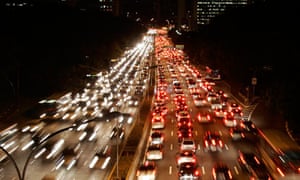In the closing decade on my own, there has been a 119% increase in the quantity Top Theto of cars on Brazil’s roads while 40% of Brazilian families now very own as a minimum one vehicle. Easy get admission to the…
In the closing decade on my own, there has been a 119% increase in the quantity Top Theto of cars on Brazil’s roads while 40% of Brazilian families now very own as a minimum one vehicle. Easy get admission to the credit has unfolded a whole new riding world and with it, gridlock and toxic tiers of air pollutants contributing to weather change.
Automobile pollutant emissions achieved ECU standards (presently an average of 0.4g/km), and excessive tiers of pollutants triggered 7,000 deaths in São Paulo in 2011. Research through the Getulio Vargas foundation estimates that São Paulo loses around $15bn a yr because of fitness troubles related to pollution, accidents, loss of productivity, and gas fees. It’s a risky road – and we are all on it.
In 2012, Brazil commenced searching for greater sustainable solutions, such as inspecting how its towns are being designed. Like maximum cities, car intake of fossil fuels is Brazil’s principal offender on the subject of weather change. Brazil’s new city mobility policy objectives to prioritize non-motorized and public transportation over the person’s automobile. The coverage will permit planners to redecorate roads giving extra area to non-motorized cars and selling greater green and sustainable transportation – the so-called “modal switch.” It’s going to ease the trouble; however, in its gift from the scheme, could the simplest hope to attain a 2% emissions discount by way of 2020.
All through the C40 Summit at Rio+20, any cities, including São Paulo and Rio, proposed a discount of greater than 1.3bn lots of Co2 as much as 2020. Quite an assignment.

Brazil plans to decrease Co2 emissions, with a goal of one hundred thirty-five grams of Co2/km by 2017. This indicates motors made in Brazil will become a great deal extra efficient. They have to obtain 17.26 km/litre of gas (presently 14 km/litre) and 11.96 km/litre of ethanol (currently nine.seventy-one km/litre). But, whilst this is genuinely a beginning, these figures are far from ECU goals Soul Crazy.
Car corporations in Brazil may also be asked to participate in a current voluntary fuel labeling program that suggests an automobile’s gas consumption and other environmental credentials. Current studies by way of Brazilian consumer organization Idec suggests that only 11 automobiles out of 107 fashions on the road are currently labeled.
However, there is a capture of those new guidelines. When the first automobiles were produced in Brazil by GM and Ford in 1956, the federal government, led via Juscelino Kubitschek, gave them fiscal incentives as the enterprise became one of the most important indicators of wealth and improvement within the country. These incentives at the moment are contradictory to the new city mobility policy, which works to position restrictions on cars. Yet, they still exist.
And the contradictions don’t forestall there. Brazil’s weather change desires for the transport zone are based totally on old government programs, such as the 2007 increase Acceleration Programme for mobility, and ineffectual voluntary initiatives, including the gasoline labeling program mentioned above. Couple with substantial investments in petroleum extraction on the Brazilian coast, and you have a toothless, divergent plan, break up throughout exclusive government ministries.
The car quandary in Brazil is the same as that in maximum nations. Clients global, mainly the ascending middle magnificence, need automobiles. Clean get admission to the credit is making vehicle ownership a reality. Financial incentives for the car industry courting from the Fifties suggest car manufacturers are glad to set up keep pretty a great deal everywhere.
RELATED ARTICLES :
- Closing digit automobile rationing manner that cars with registration numbers
- NBK Automobiles launches E-Class Coupe
- What is the perfect combination of line and curve that makes a car beautiful? Jonathan Glancey on the aesthetics of the automobile
- Are automobiles becoming soulless machines?
- Automobile Marketplace Droom Makes
Dependable, low priced, secure public transportation and proper infrastructure for pedestrians and cyclists are pipe goals in most countries. The imaginative and prescient of sustainable city mobility will most effective come with radical – and important – modifications to current automobile-primarily based cities, which in Brazil and many countries are stagnant and unsustainable.
Fulvio Giannella is the government co-ordinator, and João Paulo Amaral is a sustainable consumption researcher at Idec (the Brazilian Institute for purchasers Rights). Idec is a member of purchasers international.
Popular
-

The Weird Quantum Property of ‘Spin’
You could think that electrons would be easy sufficient to…
1950 0 -

MSI GeForce GTX 1080 Gaming Z review: Living the 4K dream?
It’s not regularly that we assess supplier-particular variations of photo…
2078 0 -

-

Don’t Compare Yourself to Celebrities
Comparing yourself to others is never a healthy habit –…
2212 0 -

How to Train the Computer In Your Brain to Better Judge Cornering Speed
This column’s regular readers will understand my respect and affection…
2016 0
Latest News
Even in our digital age, some jobs stay nearly as dirty and threatening as ever. Mining is a prime instance…





















